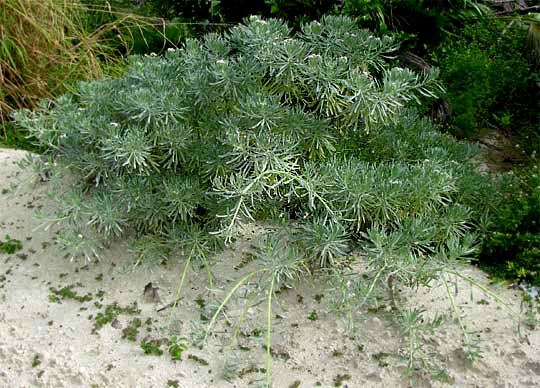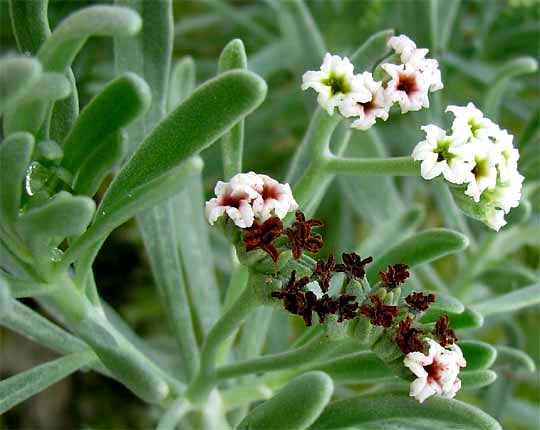Excerpts from Jim Conrad's
Naturalist Newsletter
from the December 29, 2008 Newsletter written at Mayan Beach Garden Resort 20 kms north of Mahahual; Caribbean coastal beach and mangroves, ~N18.89°, ~W87.64°, Quintana Roo state, MÉXICO
SEA-LAVENDER

An extremely common, grossly underappreciated and unnoticed shrub on sand facing the ocean here is shown above. In English this dense, waist-high, woody, fuzzy-leafed, gray-green shrub can be called Sea-Lavender or Sea-Rosemary, though Lavender and Rosemary reside in the Mint Family, while this plant, known technically as TOURNEFORTIA GNAPHALODES, is a member of the Borage Family, the Boraginaceae.:

The plant in the picture grows atop a ridge thrown up by machinery keeping sand off the road. Notice the long, pale "sucker stems" at the bush's base. On the beach these growths catch windblown sand and are quickly buried, giving the impression that the plant is a thicket. Leaves inside the plant tend to turn black, shrivel and fall off, causing the bush to be fairly open and dark inside, while presenting a dense, pale surface to the harsh external world. You can imagine that birds, crabs and other critters find wonderful shelter here.
Sea-Lavender has been so conspicuous on so many sandy beaches I've been on in the Yucatan that I figured the species must be one of those very vigorous, very widely distributed species, almost like Coconut Palms. However, on the Internet I read that Sea-Lavender occurs only in the Caribbean area, Bermuda, the southernmost tip of Florida (where it's listed as endangered), and here in the Yucatán.
Ecologically, Sea-Lavender has been called a "frontline species" because on the beach it's often the first large plant you run into as you walk away from the water. This plant demonstrates a remarkable ability to survive in full sun and in constant wind carrying salt spray. Sea-Lavender flowers year-round, but blossoms most prolifically during the winter dry season. Its flowers emit a modest sweet, perfumy fragrance, and it's a wonderful thing to be walking across the beach's sizzling, blinding sand and smell such a delicate perfume wafting from such a no-nonsense-looking plant.